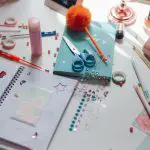Are you looking to attach patches to your clothing or accessories without having to sew them on? Maybe you don’t have a sewing machine or simply don’t want to spend the time and effort to sew them on.
Luckily, there are several alternative methods for attaching patches that don’t require any sewing. In this article, you’ll learn about six different ways to attach patches without sewing, including using heat, fabric glue, and even safety pins.
One of the most popular methods for attaching patches without sewing is using heat. This involves using an iron to melt a special adhesive backing on the patch, which then sticks to the fabric.
Another option is to use fabric glue, which can be applied to the patch and then stuck onto the fabric. Stitch Witchery is another adhesive option that involves using a special tape that is activated by heat to fuse the patch to the fabric.
Badge Magic is a newer product that uses a similar process to Stitch Witchery, but doesn’t require any heat. And if you’re looking for a temporary solution, Velcro and safety pins are also effective options.
With these methods, you can easily attach patches to any fabric without ever picking up a needle and thread.
Table of Contents
Using Heat to Attach Patches
You can easily attach your patches without sewing by using heat – all you gotta do is grab your iron and watch those patches melt onto your fabric! This is a perfect option for those who don’t have time, patience, or skills to sew. Plus, it guarantees a strong bond that won’t come off easily.
To use heat to attach patches, start by setting your iron to the appropriate temperature for your fabric. Then, place the patch on the desired spot and cover it with a thin cloth or a pressing sheet. Press down firmly with your iron for about 10-15 seconds, making sure to apply even pressure and heat. Repeat on the other side if necessary.
Once you’re done, let the fabric cool down before testing the patch’s adhesion. If it’s not fully attached, repeat the process until it is. And that’s it! You can now enjoy your customized clothing without the hassle of sewing. Just remember to follow the instructions on your patch’s packaging and to be careful not to burn yourself or your fabric.
Using Fabric Glue
When you want to attach patches without sewing, fabric glue can be a great option. However, it’s important to choose the right glue for your fabric and patch material.
Before applying the glue, make sure to prepare the fabric by cleaning and drying it thoroughly. Then, apply the glue to the patch and carefully attach it to the fabric, making sure it is secure and free of bubbles or wrinkles.
Choosing the Right Glue
Looking for the perfect glue for attaching patches? Here’s what you need to know!
When choosing a fabric glue for attaching patches, it’s important to consider a few factors. First, make sure the glue is suitable for the type of fabric your patch is made of. Some glues may not work well with certain fabrics, so be sure to read the label carefully.
Another factor to consider is the strength of the glue. You want a glue that will hold up well over time and won’t come undone easily. Look for a glue that is specifically designed for fabric and has a strong bond.
It’s also a good idea to choose a glue that dries clear, so any excess won’t be visible on your patch. By taking the time to choose the right glue, you can ensure that your patches stay securely attached for as long as you need them to.
Preparing the Fabric
To get your fabric ready for patch attachment, start by pre-washing it to remove any dirt or residue that may interfere with the glue’s ability to adhere. Use warm water and a gentle detergent to avoid any damage to the fabric.
After washing, dry the fabric completely and iron it to smooth out any wrinkles or creases. This will help ensure a clean and smooth surface for the patch to adhere to.
Next, cut the fabric to the desired size and shape for the patch. Make sure you leave enough room around the edges for the glue to spread and adhere properly. If you want to avoid fraying, you can also use pinking shears or apply a fabric fray preventer.
Finally, test the glue on a small, inconspicuous area of the fabric to make sure it doesn’t discolor or damage the fabric. Once you’re sure the glue is safe to use, you can proceed with attaching the patch.
Applying the Glue
Now it’s time to spread a thin layer of glue onto the back of the patch and carefully place it onto the fabric in the desired location, using your fingers to press down and smooth out any bubbles or wrinkles.
Make sure the fabric is clean and dry before applying the glue to ensure a strong bond. You can use fabric glue or a hot glue gun, depending on your preference and the type of fabric you’re working with.
When applying the glue, be careful not to use too much as it can seep through the patch and leave a messy residue. It’s best to start by applying a small amount and adding more if needed.
Once the patch is in place, let it dry completely before handling or wearing the garment. This usually takes a few hours, but it’s best to follow the manufacturer’s instructions for the specific glue you’re using.
With a little patience and attention to detail, you can easily attach patches without sewing and give your clothes a personalized touch.
Attaching the Patch
You’re ready to give your garment a unique and personalized touch by carefully placing the patch onto the fabric using a thin layer of glue and smoothing out any bubbles or wrinkles with your fingertips.
Follow these three simple steps to attach the patch without sewing:
- Position the patch onto the desired area of your garment.
- Apply a thin layer of glue onto the back of the patch and spread it evenly.
- Press the patch onto the fabric and hold it in place for a few seconds until the glue sets.
It’s important to note that the glue may take a few hours to fully dry, so avoid wearing or washing the garment until the glue has completely set.
By following these steps, you can easily attach patches without sewing and create a unique and personalized look for your clothing.
Using Stitch Witchery
First, grab the Stitch Witchery and your patch. This is a great option for those who don’t want to sew or don’t have access to a sewing machine.
Cut a small piece of Stitch Witchery to the size of your patch. Then, place the patch on the desired location and put the Stitch Witchery on top of it, making sure that the rough side of the Stitch Witchery is facing down towards the fabric.
Next, cover the patch and Stitch Witchery with a damp cloth and press down with a hot iron. Be sure to hold the iron in place for about 10-15 seconds to ensure a strong bond. Repeat this process on the other side of the fabric to ensure the patch is secure.
Let the fabric cool and check to make sure the patch is firmly attached. If the patch is not completely secure, repeat the ironing process until it is.
You can now enjoy your newly decorated garment without the hassle of sewing. Stitch Witchery is a quick and easy way to attach patches to any fabric, making it a great option for those who want to add a personal touch to their clothing.
Using Badge Magic
If you’re looking for an easy and quick way to attach patches without sewing, then you might want to try using Badge Magic. This product is a double-sided adhesive that allows you to attach patches to any fabric without the need for needles or thread.
To get started, you’ll need a few materials such as Badge Magic sheets, a pair of scissors, and an iron. Follow the step-by-step instructions carefully to ensure a successful application. Don’t forget to read some tips and tricks to make the process even smoother.
What is Badge Magic?
Badge Magic is a no-sew adhesive that allows you to attach patches easily and quickly. It’s a convenient and mess-free alternative to sewing, making it perfect for those who don’t have the time or skill for needlework. Here are four things you need to know about Badge Magic:
-
It comes in sheets or pre-cut shapes: Badge Magic adhesive comes in sheets that you can cut to size, or in pre-cut shapes that fit common patch sizes. This makes it easy to customize the adhesive to your patch, ensuring a secure hold.
-
It’s strong and durable: Despite being a no-sew solution, Badge Magic is incredibly strong and durable. It can stand up to washing, drying, and even ironing, ensuring that your patch stays in place for a long time.
-
It’s easy to use: Applying Badge Magic is simple and straightforward. Just cut the adhesive to size, peel off the backing, and stick it to the patch. Then, remove the second backing and attach the patch to your garment or accessory.
-
It’s versatile: Badge Magic can be used on a variety of fabrics, including cotton, denim, and nylon. This makes it a great choice for attaching patches to clothing, bags, hats, and more.
Required Materials
Get ready to easily and quickly customize your clothing and accessories with a mess-free solution that doesn’t require any needlework – all you need are a few simple materials.
To attach patches without sewing, you’ll need Badge Magic. It’s a fabric adhesive that can be easily found in craft stores or online. You’ll also need a pair of scissors, a ruler, and a pen or marker.
Badge Magic comes in sheets or rolls, and you can choose the size that best fits your needs. It’s a double-sided adhesive that is activated by pressure and heat, making it perfect for attaching patches to almost any fabric.
With just a few simple steps, you can have your patches attached in no time. And the best part? You won’t have to deal with the hassle of sewing or worry about damaging your clothes.
Step-by-Step Instructions
Easily personalize your clothing and accessories with a mess-free solution that requires no needlework by following these simple steps.
First, pick the patch you want to attach and make sure the fabric you’ll be sticking it to is clean and dry. If it’s a new item, wash and dry it before starting the process.
Next, place the patch on the desired spot and secure it with a piece of cloth or towel. Using a hot iron, press firmly down onto the patch for around 20-30 seconds. Make sure to apply pressure evenly, going over the edges and corners.
Once done, let the patch cool down before testing its hold. You can also add a few extra touches like stitching around the edges or adding more patches to create a unique design.
With these easy steps, you can attach patches to your clothes and accessories without the hassle of sewing.
Tips and Tricks
Now that you know the step-by-step instructions for attaching patches without sewing, let’s dive into some tips and tricks to make the process even easier.
First off, it’s important to choose the right adhesive for your patch and fabric. Some adhesives work better on certain materials, so be sure to do your research beforehand. You can also test the adhesive on a small, inconspicuous area before applying it to the entire patch.
Another tip is to make sure your fabric is clean and dry before attaching the patch. Any dirt, oils, or moisture can weaken the adhesive and cause the patch to fall off. If you need to clean the fabric, use a mild detergent and let it air dry completely before attaching the patch.
Additionally, you can use a hot iron to activate the adhesive and ensure a strong bond between the patch and fabric. Just be sure to follow the instructions for the adhesive you choose and use a pressing cloth to protect the patch from direct heat.
By following these tips and tricks, you can attach patches without sewing with confidence and ease.
Using Velcro
Attaching patches without sewing can be a hassle, but using Velcro makes it a breeze! You’ll love how quickly and securely your patches will stick to your clothing or gear. Velcro is a great option for those who don’t want to permanently attach patches to their clothes or gear, or for those who want the flexibility to change out their patches frequently.
Here are some tips for using Velcro to attach your patches:
-
Start by choosing the right type of Velcro for your patch. There are two types of Velcro: sew-on and stick-on. Stick-on Velcro is the easiest to use, as you can simply peel off the backing and stick it directly onto your patch. Sew-on Velcro is more secure, but requires you to sew the Velcro onto your patch first, before attaching it to your clothing or gear.
-
Once you have your Velcro attached to your patch, you’ll need to prepare the surface you’ll be attaching it to. Make sure the surface is clean and dry, and free of any dirt or debris. If you’re attaching the patch to a piece of clothing, make sure it’s not wrinkled or stretched out.
-
Finally, attach your patch to the surface using the Velcro. If you’re using stick-on Velcro, simply peel off the backing and press the patch firmly onto the surface. If you’re using sew-on Velcro, make sure you sew the patch onto the surface securely, using a strong thread and a tight stitch. Once your patch is attached, you can enjoy showing it off on your clothing or gear!
Using Velcro to attach your patches is a great way to add some personality to your clothing or gear, without having to commit to a permanent attachment. With these tips, you’ll be able to attach your patches quickly and securely, and enjoy showing them off wherever you go.
Using Safety Pins
To add a punk-rock vibe to your outfit, try using safety pins to secure your patches onto your clothing or gear. This method is quick, easy, and doesn’t require any sewing skills.
Simply select the patch you want to attach, position it on your clothing or gear, and secure it in place with a few safety pins. When using safety pins to attach patches, it’s important to make sure the pins are securely fastened. This will prevent the patch from falling off and getting lost. To do this, use multiple pins and place them at different points around the patch. This will help distribute the weight of the patch and keep it in place.
Another benefit of using safety pins is that they allow you to easily switch out patches as desired. You can remove a patch and attach a new one in just a few seconds. This is a great option if you have a collection of patches that you like to rotate on your clothing or gear.
So, give this method a try and see how it adds some edge to your look!
Removing Patches
Ready for a new look? Easily switch out your favorite patches by removing them with these simple tips.
-
First, locate the edges of the patch and gently pull it off from one side to the other. Be careful not to damage the fabric underneath.
-
If the patch has been attached for a long time, it may leave behind some adhesive residue. To remove it, apply a small amount of rubbing alcohol or nail polish remover onto a cotton ball and dab it onto the area. Gently rub until the residue comes off.
-
If the patch is made of delicate material, such as leather or suede, use a hair dryer on low heat to loosen the adhesive before removing it.
Now that you know how to remove patches without damaging your clothes, the possibilities are endless. Mix and match your patches to create a new look every day. Don’t be afraid to get creative and show off your unique style. Happy patching!
- Why Poly-Cotton Is the Go-To Fabric for T-Shirts and Hoodies - June 23, 2025
- 50/50 Cotton Polyester Blend vs. 100% Cotton: An Ultimate Showdown - June 23, 2025
- Is Cotton Polyester Fabric Breathable? The Surprising Truth - June 23, 2025




